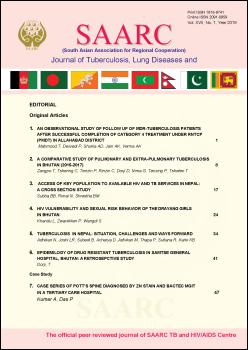Tuberculosis in Nepal: Situation, Challenges and Ways Forward
DOI:
https://doi.org/10.3126/saarctb.v17i1.25026Keywords:
Tuberculosis, Situation, TB, Challenges, NepalAbstract
Introduction: Globally, tuberculosis is a major public health problem. Moreover, the emergence of drug resistant forms of TB has threatened TB prevention and treatment efforts. Despite the long history of tuberculosis prevention efforts, tuberculosis still ranks among the top ten causes of deaths in Nepal. Furthermore, Nepal being land locked with two high TB burden countries i.e. India and China, it has added difficulties to National Tuberculosis program. Hence this study aims to review the situation of National Tuberculosis Program in Nepal and explore the possible challenges and ways forward for NTP to strengthen the TB diagnostics and treatment services in Nepal.
Methods: This study is based on the review of available literatures and data sources related to tuberculosis prevention, care and control. Secondary data published by National Tuberculosis Program in the annual report for the year 2015, 2016 and 2017 were considered for the situation analysis of tuberculosis in Nepal. We used different platforms like Google scholar, PubMed to search relevant literatures.
Results: This has been a huge gap between WHO TB estimates and TB cases notification by the national system. It was 22% in 2015, 27% in 2016 and 29% in 2017. However National Tuberculosis Program has maintained treatment success rate consistently above 90%. Tuberculosis program has yet not achieved universal HIV testing, although HIV testing among TB patients has increased rapidly. Similarly, only 75%, 1994 received DST out of 2601 retreatment TB cases have received DST in 2017 despite guideline suggest mandatory drug susceptibility testing for retreatment TB cases.
Conclusion: Case notification has reduced gradually. It is difficult to achieve the target envisioned by NSP 2016-21 if the current case notification trend persists. NTP needs to expand service sites ensuring minimum quality standards as well as scale up targeted intervention addressing human right issues to identify the missing TB cases. NTP needs to regulate the quality of diagnosis and treatment TB services offered by private sector.
Downloads
Downloads
Published
How to Cite
Issue
Section
License
Copyright © SAARC Tuberculosis and HIV/AIDS Centre (STAC), all rights reserved, no part of this publication may be reproduced, stored in a retrieval system or transmitted in any form or by any means without prior permission of the STAC.





